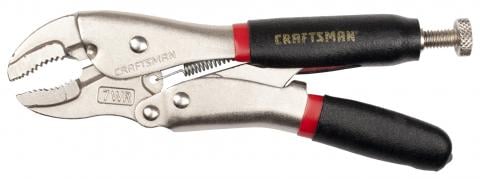Linkages are designed to convert some input motion into a different output motion. A linkage typically consists of a series of rigid bodies called links, connected together by freely rotating joints. Typically, one link is fixed and cannot move, and one link is driven in some input motion. Linkages are a fundamental part of machine design because of their ability to create such a wide variety of output motions and their ability to alter the path, velocity, and acceleration of the input. Very precise and somewhat complicated motions can be designed using a simple linkage design. Linkage motions are extremely repeatable.
Linkages are found in many places throughout the world. Below is an example of a simple linkage found on a pair of Vice Grips.
The first picture above shows the linkage in one configuration. The link at the bottom is the input link which is driven, and the link at the top is the fixed link. The second picture shows the linkage at the other end of its motion. This is a linkage with four links, each link has two joints. This is one of the most common types of linkage systems.
Four Bar Linkages:
One of the simplest and most common linkage types is the four bar linkage. This is a linkage system which can provide a wide variety of motions depending on its configuration. By varying the length of each link, one can greatly change the output motion. The most basic type of 4-bar linkage is one where the links are equal length and parallel to each other, as seen below:
In this particular setup, as the linkage travels through its motion the output link will remain parallel to the fixed link. As such, the claw remains in a consistent configuration. This would be useful for an application where the object manipulator must remain in the same orientation relative to the ground. However, not all 4-bars take this configuration.
In this example of a four-bar linkage, the output motion is very different from the previous example! By tweaking the lengths of the different links, a designer can create many different designs. Using the VEX Robotics Design System it is easy to experiment with linkages to test their different motions.
The above linkage prototypes can be created with only a few VEX metal pieces, and a few screws.


